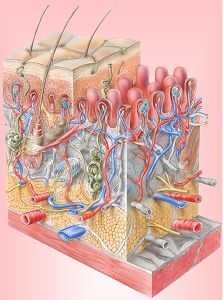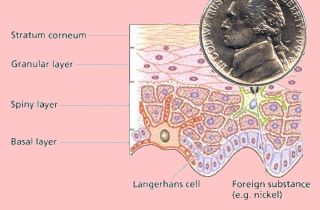by Boyd Martin

Although those of us who are actively working on self-improvement are constantly asking such questions as, "What are the underlying issues in my life?" or "What is the deeper meaning to this relationship," or "What's happening to this person beyond skin deep?"--it's sometimes easy to miss the forest for the trees, and take our physical skin for granted, as if it was more of a veil to be pierced rather than the amazing human organ that it is.
I decided to make a point of finding out what makes this human organ so amazing. Here are some highlights of my research:
The skin is constantly growing from the bottom upwards. Dead skin cells are shed from the surface. Ninety percent of "dust particles" in your home are actually shed dead skin.
Humans shed about 600,000 particles of skin every hour--about 1.5 pounds a year. By 70 years of age, an average person will have lost 105 pounds of skin. Humans shed and re-grow outer skin cells about every 27 days - almost 1,000 new skins in a lifetime.
The average adult has 21 square feet of skin (about the size of a shower curtain) containing approximately 300 million skin cells.
On average each square half-inch of skin contains: 10 hairs, 15 sebaceous (oil) glands, and 100 sweat glands.
The skin on the palms and soles of the feet is 10 times thicker than the skin on the face, and five times thicker than the skin on the rest of the body. The skin is thinnest on the lips and around the eyes.
The total skin of an average-size person weighs about 8 pounds.
Each square inch of human skin consists of 19 million cells, 19 feet of blood vessels, and 19,000 sensory cells.
There are 45 miles of nerves in the skin of a human being.
Feats of Skin
As the largest organ in the human body, skin could be thought of as the mirror of what it covers. Holistic practitioners see the skin as one of the first diagnostic reports about what's going on with a body's endocrine system, nervous system, and blood and lymph circulation. Other than externally-caused injuries (insect bites, burns, or other environmental exposures), unwanted skin conditions are invariably a result of some body system imbalance.
Besides being the largest, the skin is the most complex organ in the human body. If only one of these crucial functions of the skin stops working, we would die:
Providing the sole protective barrier between all the body systems and the outside environment, particularly the sun.
Preventing excessive water loss from the body.
Protecting the body from infection.
Giving mechanical protection to the body from bumps and knocks, with the collagen absorbing most of the force.
Removing waste products of metabolism from the epidermis, which are also carried away in the blood and lymph.
Providing shape and form to the body by holding all its structures together.
Regulation of body temperature through control of blood flow and sweating.
Providing skin sensations of touch, pain, heat and cold, protecting the body from potential harm (and leading it to potential pleasure...)
Skin Immunity
 The natural layer of oil-in-water emulsion on the skin is the first barrier against invasion by micro-organisms such as bacteria, fungi and yeasts. The stratum corneum provides the next level of defense. White blood cells in the skin can capture and destroy bacteria invading the skin. As a result, pus may form.
The natural layer of oil-in-water emulsion on the skin is the first barrier against invasion by micro-organisms such as bacteria, fungi and yeasts. The stratum corneum provides the next level of defense. White blood cells in the skin can capture and destroy bacteria invading the skin. As a result, pus may form.
The skin also contains special defense cells (Langerhans cells) spread out amongst the bottom layer. These cells mop up invading foreign substances that have found their way through the top layers, and take them off to special white cells (lymphocytes) in the lymph glands. Here they are neutralized.
An important element of defense concerns chemicals. If a chemical such as nickel is constantly absorbed through the skin, say from a button on one's jeans, it is first taken up by the Langerhans cells; later, however, special lymphocytes called T-cells make antibodies to that chemical. This can in time lead to an allergic skin reaction at the site of the button as the T-cells rush to meet the invading chemical. Inflammation occurs and other skin responses set in, such as itching, damage from scratching, direct exposure of blood to the chemical, scabbing and scarring. Thus, the skin is really semi-permeable. It does not stop everything from entering the body. This is a consideration with cosmetics, soaps and detergents. How much actually got through past the antibody reaction of the Langerhans cells? Thus, the regular use of organic, natural cosmetics, soaps and lotions, not to mention using natural substitutes for household chemicals, is an important part of any health regimen, to help reduce the toxic load on the body when skin protection is overwhelmed.
What's Your Skin Type?
SKIN
MYTH
Drinking six or eight glasses of water a day will keep skin moisture
levels high, and is an essential factor in renewing cells and hydrating
the skin to prevent wrinkles from forming.
Fact:
Although it is important to drink six to eight glasses of water per day, it will not cause water to enter the skin selectively, unless the person is seriously dehydrated. Normal skin is well hydrated naturally. The excess water goes into all the tissues of the body, and ultimately to the bladder! Drinking pure, fresh water assists the body's eliminative organs to remove toxins from the whole body system, and so the skin benefits, too.
|
Interestingly, in scientific and commercial surveys, 70% of women claimed they had "sensitive skin." Beyond the social metaphors that may be driving that perception, let's look at what dermatologists look for in determining skin type.
Normal Skin
Clear appearance
Even color
Feels neither tight nor greasy
Soft and supple to the touch
A high degree of elasticity
Normal skin may be said to have nothing obviously wrong with it, and no sensations of discomfort. It results from a balance of the normal skin functions (including new skin cells being formed and old ones being lost, together with well-controlled water loss, oil secretion and sweating). This creates a balanced state of suppleness, elasticity, color and hue.
Dry Skin
Feels tight and irritable
Often looks flaky
Often develops fine lines around the eyes
Tightens further after washing with soaps or detergents or prolonged exposure to low humidity.
Dry skin is characterized most of all by the sensation of tightness, with the skin feeling rough and scaly and visible lines developing. At its worst it may look cracked. The problem lies in poor skin function, and damage to the water/lipid barrier film, shown by an increase in the rate of water loss. Dryness is a significant problem associated with mature skin as hydration ability progressively decreases with the consequent loss of suppleness and flexibility.
Oily Skin
(sometimes called Seborrhoeic skin)
Oily skin generally appears at puberty, although in a few people it starts much earlier, from the age of six upwards. It is rare after the age of 35. It involves only the upper part of the body, where greater numbers of sebaceous glands are found. This type of skin is particularly common in adolescents and young adults. At this age there is in both sexes a dramatic increase in sebum production under the influence of the sex hormones. The extra sebum gives the skin a shiny appearance, especially on the nose and forehead. The skin tends to thicken, due to increased keratin production, and the pores dilate. As a result the skin feels rough and irregular.
Combination Skin
Characterized on the face by thickened, shiny skin with patches of dry skin.
Sensitive Skin
In addition to these recognized types of skin, many people believe that they have "sensitive skin." Doctors and scientists do not agree about what "sensitive skin" is, since the term has subjective connotations, but it may generally be considered as skin which is easily irritated. It is more commonly associated with people with Normal Type Skin, and probably has a genetic element.
Some people with this condition cannot tolerate contact with any cosmetic products no matter how well-formulated they may be. Sensitive skin can be associated with a medical condition called atopy, where there is an inherited predisposition to eczema, hay fever, asthma and other allergies.
Atopic Skin
About 20% of the population have the inherited condition called atopy, which can lead to various degrees of dry skin or even eczema. People with this problem need to take extra care of their skin. Atopic skin tends to have a higher than average water loss characteristic, and can be very sensitive to irritants.
No one knows the precise cause of atopy, except that it has a genetic component: 70% of patients with atopic dermatitis have at least one relative who suffers from either eczema, asthma or hay fever.
The Care & Feeding of Your Skin
Beyond the daily routines of skin care and some smart avoidance strategies covered in our Skin Care Tips article, there have been some recent technological breakthroughs in skin repair and nutrition.
One such high-tech breakthrough is the use of liposomes to transport nutrients and healing formulas. Liposomes work by mimicking the molecular makeup of the skin in order to fully penetrate the skin's outer layers to arrive in the most active, or "basal," layer where it can be distributed throughout the body. The skin's cells are classified as "phospholipids"--basically a molecule that can repel and absorb water or oils simultaneously. The liposome is one section of the phospholipid molecule surrounded by fatty acids. Using an advanced process it is now possible to "build" phospholipids from soybeans, and "inject" their liposomes with nutrients and healing formulas. This creates a truly "transdermal" substance that can travel through all layers of the skin providing deep and effective usage of the healing formulas.
At Pure Energy Rx we are now featuring the Elina Skin Care line of products based entirely on this liposome transport modality. Enhancing the effects of this breakthrough, these products are bio-energized with various Subtle Energies that create another quantum leap in the effectiveness of the formulas [MORE INFO]. Results in many cases are obvious and rapid.
We've compiled a series of before-and-after pictures of a few of Elina's spa clients who have had just one treatment where Elina's bio-energized transdermal liposome formulas were applied. (More photos).


Read more about the liposome technology on our website. These formulas give new hope to sufferers of stubborn skin conditions, as well as those inevitable signs of aging.
Please check out our new Healing Sea Buckthorn Lotion. We know you'll love these very natural and totally organic skin products!





